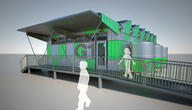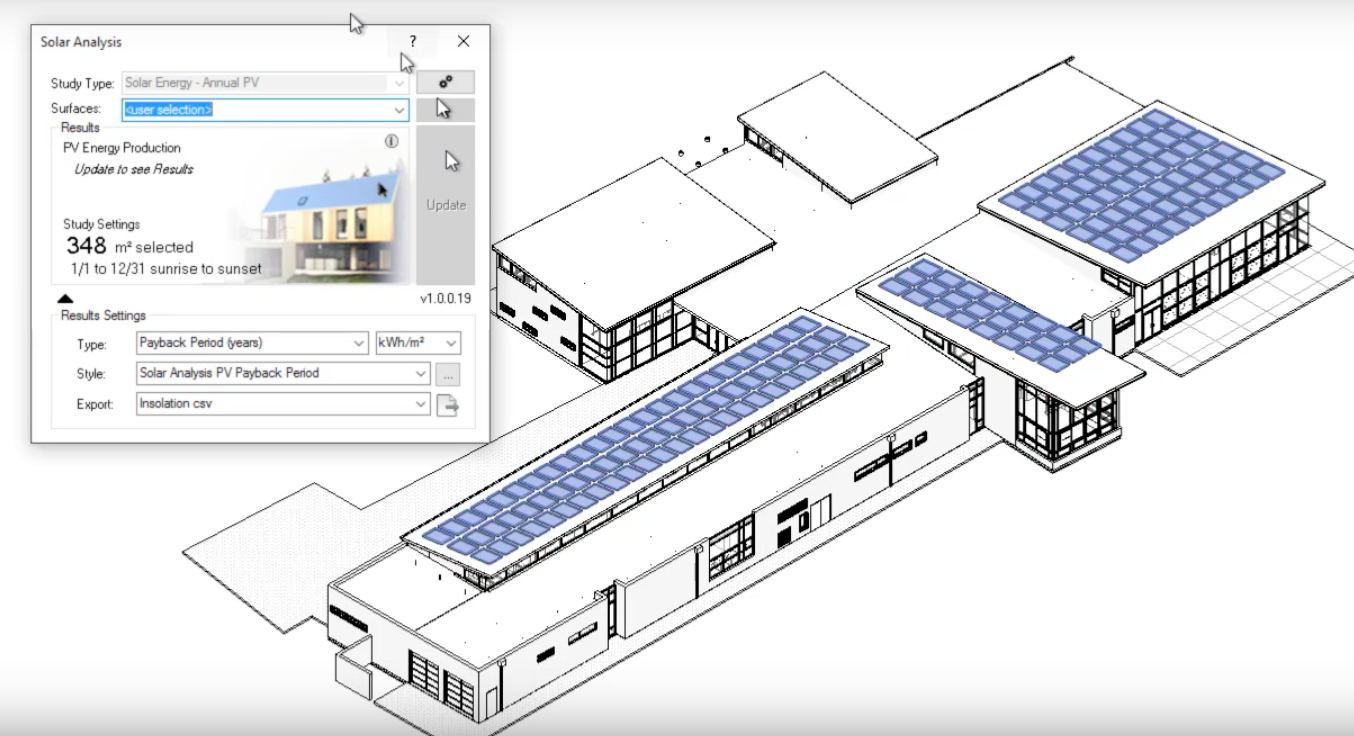You are here
Solar photovoltaics (PVs) create electricity directly from sunlight. They are the most common form of on-site clean energy generation. Many people generically refer to them as "solar panels" or "solar power".
Solar PV is useful because the sun provides a tremendous resource for generating clean and sustainable electricity without toxic pollution, moving parts, or noise on-site. It is also abundant.
|
PV Panel array photo: Jeremy Faludi |
Solar power production at any given moment is measured in watts, but the important variable to measure is energy generation (kWh) per day or month or year. Because of sunlight's intermittency, PV panels can generate very high wattages some parts of the day but low wattages at other times, and will generate no wattage every day after the sun sets.
Every day, the sun showers the Earth with over 5,000 times as much energy as is used by all of humanity. However, PV panels have limited efficiency, buildings have limited area for arrays, cost is generally high, and some climates receive significantly less sunlight than others. As a result, PVs are not appropriate for all occasions. In many cases, buildings should strive to reduce energy demand with passive solar design as much as possible before turning to solar electricity generation.
Predicting PV Power Production
The amount of energy produced by PVs depends on five main factors:
- The site conditions: latitude, longitude, and local weather
- The orientation and exposure of the panels to the sun
- The efficiency of the panels
- The available area for panels
- The power conversion electronics
Site Conditions
The first thing to determine the feasibility of a solar PV installation is the site conditions: how much sunlight hits the site? This is known as "solar potential," "incident solar radiation," or sometimes "insolation." It is measured in Wh/m2•day or kWh/m2•year. Various maps exist for solar potential around the world.
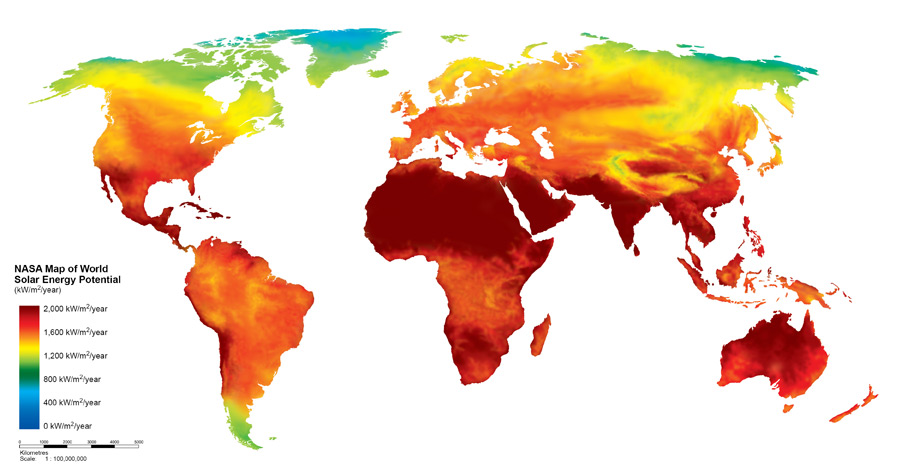 |
| Solar energy potential map of the world (image source: NASA) |
Determining how many kilowatts of energy strike the site per square meter per year will let you calculate how big and how efficient your PV array will have to be to meet the building's energy needs.
For some locations there are even online calculators, such as the US Department of Energy's IMBY, that will take into account everything you need to make a decent estimation--incident solar radiation, latitude, panel efficiency, orientation, and balance of system.
System Orientation
|
Sun-tracking PV installation (Photo by Jeremy Faludi) |
The more directly the sun shines on solar panels, the more energy they generate.
The rule of thumb for the angle to mount PV panels for optimal power generation over the course of the year is to use the same angle as the latitude (in degrees). To maximize winter production, add 15 degrees. To maximize summer production, subtract 15 degrees. While this is a good starting point, the analysis tools can help you design your system more precisely than these rules of thumb.
In latitudes farther from the equator, panels placed at the angle of the sun can generate as much as 20% more electricity than panels placed flat.
Some PV systems are mounted on poles and motorized arrays to track the sun from east to west as it moves through the day. These tracking systems can increase productivity as much as 35%, but add significant cost (source: US Department of Energy derating calculations). Thus they usually only make financial sense for use with high-efficiency panels.
Panel Efficiency
There are a wide variety of PV panels: crystalline silico, thin film, and concentrating are three overall categories that each comprise many different kinds. The kind of panel determines the efficiency with which sunlight is converted into electricity.
 |
| Different PV panels: crystalline silicon, amorphous silicon, and dye-sensitized |
Generally speaking, crystalline silicon panels are higher-efficiency than thin-film panels, but this depends on many factors, such as age, manufacturing process, and the sunlight conditions. Crystalline silicon systems tend to lose more performance in overcast skies and partial shade than thin-film panels do, and concentrating panels generally require full direct sun.
Typical commercially-available PV panels have efficiencies from 5 - 20%. Any given panel will have a "nominal power" rating in watts. This must be converted to an estimate of annual energy production, using the climate data of the local site conditions. Then the size of the system can be estimated.
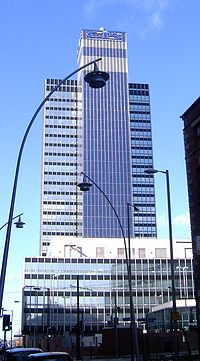 |
|
Building-integrated photovoltaic windows greatly expand available area (from Wikipedia) |
System Area
The available area for solar panels may be a limiting factor for the system. The area required for a PV system depends on the efficiency of the panels and the amount of sunlight. This is always a matter of cost. Since less-expensive panels are lower-efficiency, more area is required for them.
Roofs are the typical locations for PV panels, but locating panels over parking lots not only provides additional area, but also shades the cars and asphalt, lowering the urban heat island effect.
Photovoltaics do not have to be separate standalone devices--they can be built into other building products. Roof tiles, standing seam roofs, even windows can be equipped with PV cells so that the available area for power production can be greatly enlarged. Such systems are called building-integrated photovoltaics.
Building-integrated photovoltaics can be beneficial not only because they make more area available, but also because they can reduce the cost of installation. While the hardware is often slightly more expensive per watt than dedicated PV panels, they lower labor costs. Instead of hiring a roofer to lay the roof and then solar installers to mount PV panels, solar roof tiles can be installed by a qualified roofer.
Power Conversion
 |
|
Inside a PV inverter (photo from Wikipedia) |
Finally, to determine PV power production you must estimate losses to the inverter and wiring of the system--the parts that convert low-voltage DC power from the solar cells into the medium-voltage AC power of wall outlets. These are usually considered part of "derating factors", and can require you to increase the size of your system by 5 - 25%.
Power conversion efficiency can be maximized by choosing an efficient inverter and other components, and wiring panels together to avoid circuit imbalances due to some panels receiving full sun while others are shaded.
Some kinds of panels, such as crystalline silicon, can be more sensitive to wiring setup than others, as shade from nearby trees or other objects can significantly drop their voltages and cause circuit imbalances. In these cases, the wiring can make a bigger difference. Devices such as micro-inverters can isolate panels from each other to maximize production.
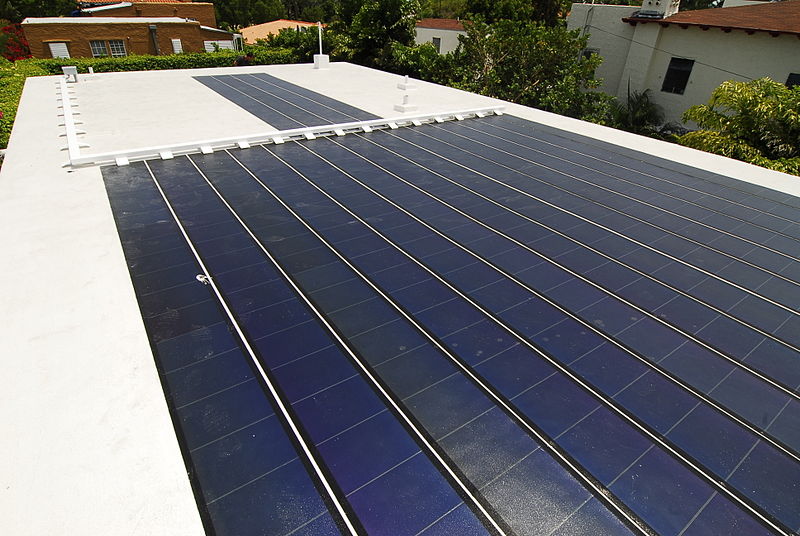 |
|
Large areas can be low-efficiency (image from Wikimedia Commons; photo by Ken Fields) |
Efficiency vs. Cost
Most people assume that higher efficiency is better, but when sunlight is so abundant and free, that it not always true. More efficient panels are generally more expensive, and are only necessary when the available area is limited. Less expensive panels covering a larger area can produce more power.
The limiting variable for many projects, then, is not energy efficiency but cost efficiency. The amount of money per watt drives how much solar power can be installed.

